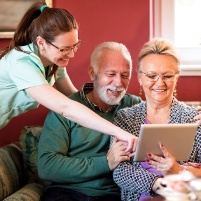
A recent white paper written by the National Alliance for Caregivers suggests family caregiving is the next public health crisis. The white paper points out, ‘as medical professionals we ask the client if they have help but we don’t ask the help if they are able to provide care.’ Think about that for a moment. How often do you feel worried about a client headed home? Their family member said, ‘we’ve got this’ but you worry they might not once they are home. Could the spouse lift them in and out of the shower? Are they capable of remembering medications? Does their schedule allow the flexibility to drive them to follow-up appointments or check-in on them to make sure they are properly taking meds and eating a balanced meal? Is anyone noticing red flags that could signal a risk for rehospitalization? The reality is – probably not.
In our profession, this revelation isn’t anything we don’t know. It’s great that on a larger scale this is gaining attention because it does deserve the conversation – family caregivers provide a critical amount of care and they support our efforts in keeping seniors thriving.
As we prepare for a potentially looming public health crisis, the National Caregiver Alliance suggests doing five things now. And we’ve added our own thoughts to each point to get us all thinking about the proactive role we can take to support the family caregivers and our own goals in achieving successful health outcomes for seniors:
- Include caregivers as a vital member of the health care team. How are you in your own practice including family caregivers in the discussion? Are you working into the discharge plans ways to help them cope with this new role of caregiving? When we do a discovery consultation with clients, part of the conversation involves the family members – who is the client’s support system, who will do the heavy lifting, who can help and with what? Life Care Managers provide a great resource to family members by educating them on what to expect, red flags to look for, resources to connect them to, creating schedules to help them administer medications or change dressings, home modifications needed to keep them safe and guiding them through the process.
- Ensure caregivers have access to comprehensive training and information. Focus groups of caregivers found that they experience their family member’s discharge from the hospital as an abrupt and upsetting event. Many caregivers felt abandoned at a critical time, and none of the focus group participants had been referred by any health care professional in the hospital to community-based organizations for emotional support—or any other kind of support. Communication and connections to resources are key – Navigation lines, handouts with community resources, and support groups helped. Home care intervention that consisted of a specialist nurse coordinator, a 24-hour nurse telephone service with access to a home care team, a collaborative home care dossier and case file, and care protocols significantly improved caregiver quality of life after discharge from the hospital.
- Identify and implement up-to-date best practices.
 What procedures do you have in place that identifies core processes that makes involving the family caregiver a natural part of the care plan? Are there specific questions written in the discharge papers that assess the capacity of the family caregiver to care for their loved one once home? Adding these strategies can help them be part of the plan and the long-term journey.
What procedures do you have in place that identifies core processes that makes involving the family caregiver a natural part of the care plan? Are there specific questions written in the discharge papers that assess the capacity of the family caregiver to care for their loved one once home? Adding these strategies can help them be part of the plan and the long-term journey. - Guarantee and confirm that caregivers are included in intervention strategies. While you assess your client’s risk, apply those same procedures to the family caregiver. How is their health? Do they have chronic illness or other health issues that could be exacerbated by caregiving? This step should not be evaluated only at discharge but at the same time as client-check-ins days/months post-discharge. Often clients will say they are doing better but the caregiver may have insight into what is really happening. These check-ins provide another touchpoint for caregivers to ask questions, gain additional support and see how they are doing in their new role.
- Ensure health systems are family-and-patient-centered. Instead of just checking off boxes on follow-up questionnaires and check-ins, use these as an opportunity to deepen the relationship with family caregivers and focus on the conversation. Ask probing questions – how are you sleeping at night? Any concerns? What did you eat today? Have you gotten out doing the things you love? And then create a plan to help the caregiver stay healthy. It also creates a trusted relationship with someone they feel connected to and can reach out to easily.
How will these 5 things help assuage a public health crisis? Building them into our best practices now will create awareness that family caregivers need to be part of the solution. According to the study, ‘providers should see family caregivers not just as a resource in the treatment or support of a person, but rather as a partner in that enterprise who may need information, training, care, and support.’ It’s one of the reasons having a Life Care Manager on board is a great starting point to help your efforts in training and educating family caregivers on how to care with confidence.
This is just a start to the conversation and we’d love to hear what you are doing in your own practices to address the family caregiving. Share your perspective so we can all support the senior, and the ones who care for them.


